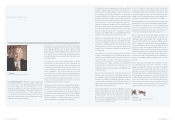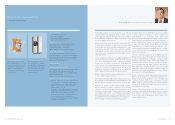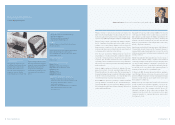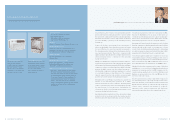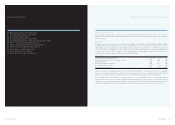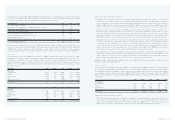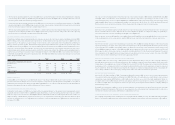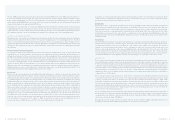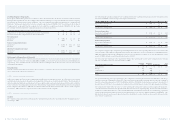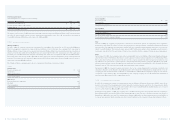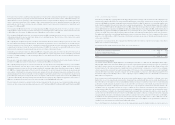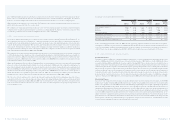Whirlpool 2002 Annual Report Download - page 21
Download and view the complete annual report
Please find page 21 of the 2002 Whirlpool annual report below. You can navigate through the pages in the report by either clicking on the pages listed below, or by using the keyword search tool below to find specific information within the annual report.
2002 Annual Report 39
Management’s Discussion and Analysis
38
the end of 2002 included an expected return on assets of 8.75% versus 10.00% at the end of 2001, and a discount rate of
6.75% versus 7.50% at the end of 2001. Our expected return on assets of 8.75% is based on historical market returns
between 1926 and 2002 applied to our allocation of plan assets. We currently expect that U.S. pension expense for 2003
will be approximately $63 million, based on the lower asset return rate and discount rate assumptions. Consolidated
expense is anticipated to be approximately $76 million.
Although most of its assets have been divested, Whirlpool Financial Corporation remains a legal entity with assets
consisting primarily of a leveraged lease portfolio. The portfolio includes investments in aircraft leveraged leases and
is affected by the economic conditions of the aviation industry. See Note 5 to the Consolidated Financial Statements.
The company continues to monitor its arrangements with the lessees and the value of the underlying assets.
CRITICAL ACCOUNTING POLICIES
Management has evaluated the accounting policies used in the preparation of the accompanying financial statements
and related notes, and believes those policies to be reasonable and appropriate. Our accounting policies are described
in Note 1 to the Consolidated Financial Statements. Certain of these accounting policies require the application of
significant judgment by management in selecting the appropriate assumptions for calculating financial estimates. By
their nature, these judgments are subject to an inherent degree of uncertainty. Our critical accounting policies include
the following:
Pension and Other Postretirement Benefits
Accounting for pensions and other postretirement benefits involves estimating the costs of future benefits and
attributing the cost over the employee’s expected period of employment with the company. The determination of our
obligation and expense for these costs requires the use of certain assumptions. Those assumptions are included in
Note 16 to the Consolidated Financial Statements and include, among others, the discount rate, expected long-term
rate of return on plan assets, and rates of increase in compensation and healthcare costs. In accordance with generally
accepted accounting principles, actual results that differ from our assumptions are accumulated and amortized over
future periods and, therefore, generally affect our recognized expense and recorded obligation in such future periods.
While we believe that our assumptions are appropriate given current economic conditions and our actual experience,
significant differences in our actual experience or significant changes in our assumptions may materially affect our
pension and other postretirement obligations and related future expense.
Income Taxes
As part of the process of preparing our consolidated financial statements, we estimate our income taxes in each of the
taxing jurisdictions in which we operate. This process involves estimating our actual current tax expense together
with assessing any temporary differences resulting from the different treatment of certain items, such as the timing for
recognizing expenses, for tax and accounting purposes in accordance with Statement of Financial Accounting
Standards No. 109, “Accounting for Income Taxes.” These differences may result in deferred tax assets and liabilities,
which are included in our consolidated balance sheets. We are required to assess the likelihood that our deferred tax
assets, which include net operating loss carryforwards and temporary differences that are expected to be deductible in
future years, will be recoverable. If recovery is not likely, we provide a valuation allowance based on our estimates of
future taxable income in the various taxing jurisdictions, and the amount of deferred taxes that are ultimately
realizable. If future taxable income was lower than expected or if tax planning strategies were not available as
anticipated, we may record additional valuation allowances through income tax expense in the period such
determination is made. Likewise, if we determine that we would be able to realize our deferred tax assets in the future
in excess of their net recorded amounts, an adjustment to the deferred tax asset would increase income in the period
such determination is made. As of December 31, 2002, we had total deferred tax assets of $698 million, net of
valuation allowances of $65 million (see Note 15 to the Consolidated Financial Statements).
In addition, we operate within multiple taxing jurisdictions and are subject to audit in these jurisdictions. These
audits can involve complex issues, which may require an extended period of time to resolve. In our opinion, adequate
provisions for income taxes have been made for all years.
Befiex Credits
As discussed above, our Brazilian subsidiaries have been recognizing benefits under the Brazilian government’s
export incentive program (Befiex) as an offset against current Brazilian federal excise tax on domestic sales. Since the
initial granting of these credits in 1996, it has been our policy to recognize these credits as they have been monetized.
There have been, however, ongoing legal proceedings relating to this program, and it is presently under review within
the Brazilian court system. We have chosen not to recognize any of our remaining credits of $207 million under the
program beyond the first quarter of 2003 until the Brazilian courts have confirmed the method used to calculate those
remaining credits.
Product Recall
The establishment of a liability for product recall expenses is occasionally required and is impacted by several factors,
such as customer response rate, consumer options, field repair costs, inventory repair costs, extended warranty costs,
communication structure, and other miscellaneous costs, such as legal, logistics and consulting. The customer
response rate, which represents an estimate of the total number of units to be serviced as a percentage of the total
number of units impacted by the recall, is the most significant factor in estimating the total cost of each recall. These
rates are impacted by several factors, including the type of product, the year manufactured, age of the product sold,
and current and past experience factors. Significant differences between our assumptions and our actual experience
or significant changes in our assumptions could have a material impact on our product recall reserves, if any.
MARKET RISK
We are exposed to market risk from changes in foreign currency exchange rates, domestic and foreign interest rates,
and commodity prices, which can affect our operating results and overall financial condition. We manage our exposure
to these market risks through our operating and financing activities, and, when deemed appropriate, through the use
of derivative financial instruments. Derivative financial instruments are viewed as risk management tools and are not
used for speculation or for trading purposes. Derivative financial instruments are entered into with a diversified group
of investment grade counterparties to reduce our exposure to nonperformance on such instruments. Our sensitivity
analysis reflects the effects of changes in market risk but does not factor in potential business risks of the counterparties
or appropriate use of instruments.
We use foreign currency forward contracts to hedge the price risk associated with firmly committed and forecasted
cross-border payments and receipts related to our ongoing business and operational financing activities. Foreign
currency contracts are sensitive to changes in foreign currency exchange rates. At December 31, 2002, a 10%
unfavorable exchange rate movement in our portfolio of foreign currency forward contracts would have resulted in an
incremental unrealized loss of $65 million, while a 10% favorable shift would have resulted in an incremental
unrealized gain of $72 million. Consistent with the use of these contracts to neutralize the effect of exchange rate
fluctuations, such unrealized losses or gains would be offset by corresponding gains or losses, respectively, in the
remeasurement of the underlying exposures.
We use commodity swap contracts to hedge the price risk associated with firmly committed and forecasted commodities
purchases that are not fixed directly through supply contracts. As of December 31, 2002, a 10% unfavorable shift in
commodity prices would have resulted in an incremental loss of $3 million, while a 10% favorable shift would have
resulted in an incremental gain of $3 million.
We utilize interest rate swaps to hedge our interest rate risk. As of December 31, 2002, a 10% shift in interest rates
would have resulted in an incremental $1 million gain or loss related to these contracts.


